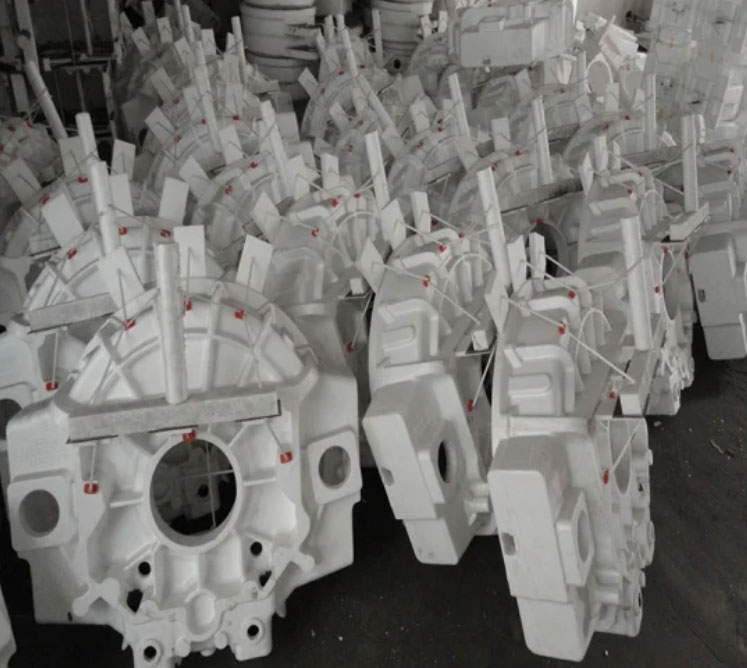
Lost foam casting (LFC) has become a critical manufacturing process for complex automotive components like transmission housings due to its ability to produce near-net-shape castings with minimal post-processing. This article explores advanced quality control methodologies for heavy-duty transmission housings using lost foam casting, focusing on defect mitigation through process optimization, material science, and computational modeling.
1. Process Optimization for Inclusion Reduction
Inclusions in lost foam casting primarily originate from coating degradation and incomplete foam decomposition. The thermal decomposition of expanded polystyrene (EPS) follows the Arrhenius equation:
$$ \frac{d\alpha}{dt} = A e^{-E_a/(RT)}(1-\alpha)^n $$
where α represents conversion degree, A is pre-exponential factor, Ea activation energy, and n reaction order. Optimizing drying parameters significantly reduces residual moisture that contributes to coating delamination.
| Parameter | Original | Optimized |
|---|---|---|
| Primary Drying | 8 hrs @ 50°C | 16 hrs @ 55°C |
| Secondary Drying | None | 8 hrs @ 60°C |
| Coating Thickness | 1.2-1.5 mm | 0.8-1.0 mm |
2. Slag Inclusion Control Through Filtration
Ceramic filters (10 PPI) installed in the gating system effectively capture slag particles. The filtration efficiency can be modeled using:
$$ \eta = 1 – e^{-k\frac{L}{v}} $$
where η = filtration efficiency, k = filter coefficient (0.35 for Al2O3 filters), L = filter thickness, and v = flow velocity. Strategic placement of Φ70 mm filters reduced slag defects by 62%.
3. Iron Penetration Prevention
Iron penetration occurs when liquid metal infiltrates insufficiently compacted sand. The critical pressure for penetration is given by:
$$ P_c = \frac{4\gamma \cos\theta}{d_p} $$
where γ = surface tension (1.2 N/m for iron), θ = contact angle (135°), and dp = sand particle diameter. Implementing dual vibration at 55 Hz with 0.5 mm amplitude improved sand compaction density by 18%.
4. Thermal Management Strategies
Optimal pouring temperature was determined through numerical simulation using the Fourier heat equation:
$$ \frac{\partial T}{\partial t} = \alpha\left(\frac{\partial^2 T}{\partial x^2} + \frac{\partial^2 T}{\partial y^2} + \frac{\partial^2 T}{\partial z^2}\right) $$
Field trials validated the ideal temperature range:
| Parameter | Value |
|---|---|
| Initial Pouring Temp | 1510°C ± 10°C |
| Mold Vacuum | 0.04-0.07 MPa |
| Cooling Rate | 25°C/min |
5. Digital Process Control
A real-time monitoring system tracks critical parameters:
$$ Q = \sum_{i=1}^n w_iP_i $$
where Q = quality index, wi = weighting factors, and Pi = process parameters (temperature, humidity, vacuum). This system reduced process variability by 43% compared to manual controls.
6. Mechanical Property Enhancement
The relationship between cooling rate and tensile strength follows:
$$ \sigma_b = 250 + 150\log(\dot{T}) $$
where σb = tensile strength (MPa) and \dot{T} = cooling rate (°C/s). Controlled solidification achieved Grade 250 cast iron properties consistently.
7. Economic Impact Analysis
Implementation of lost foam casting optimizations yielded significant improvements:
| Metric | Before | After |
|---|---|---|
| Scrap Rate | 8.2% | 3.9% |
| Energy Consumption | 1.2 kWh/kg | 0.8 kWh/kg |
| Production Cycle | 48 hrs | 36 hrs |
These advancements in lost foam casting technology demonstrate that systematic process optimization combined with computational modeling can significantly improve quality while reducing manufacturing costs for heavy-duty automotive components. Future developments in real-time adaptive control systems promise further enhancements in casting reliability and dimensional accuracy.
